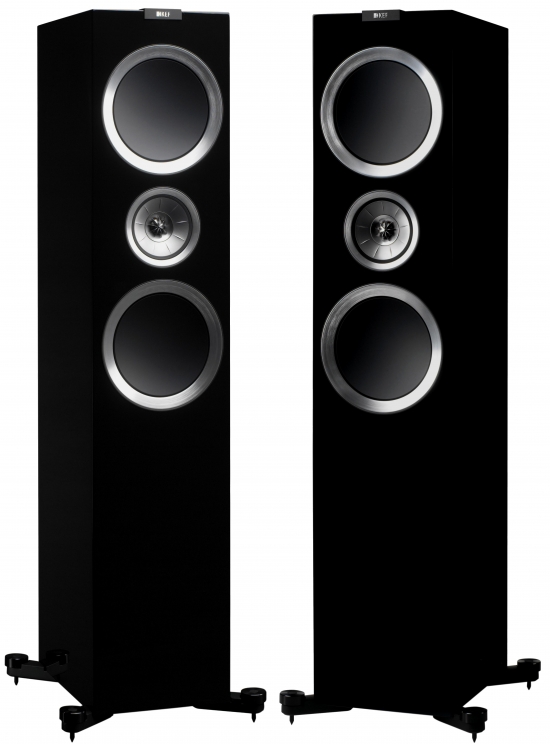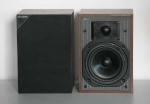Speaker pair KEF R900
On an example of a pair of flagship R900, heading the line-up of nine different types of speakers, clearly shows that the new generation of British Acoustic developers seriously decided to reform not only the design, but all the internal content. LATEST VERSION coaxial drivers Uni-Q, had time to shine as a family an average price category Q-Series, and before being tested in the model number XQ, - it is certainly one of the general elements of the modernization. Say the best is the enemy of the good. It often happens that when a new acoustic changes reduced to mere freshening its appearance, symbolic refinements crossovers yes updating colors. As we understand it, for all the sound is not very significant. But the only truly new head can give a radical change in the sound. Gloss induce mainly companies that are unable to produce their own dynamics (the majority) and procuring already finished products is very diverse , but still limited range of Danish and Norwegian firms. KEF makes the dynamics of in-house and is therefore only applies to a minority. Fortunately, traditional.
Coaxial structure Uni-Q - exceptionally tenacious technology used by early as the fifth or sixth generation of its speakers for almost 20 years. It would seem, for such term and can teach woofer squeak, much potential for modernization will probably be almost exhausted. In addition, competitors are not asleep. Physical simulation of a point source of sound waves in a wide frequency range - quite a difficult and noble engineering task. Most musical instruments - quasi-point sources of spherical sound waves, and their sizes are comparable to or less than the length of the emitted waves. Logic says that the speakers should be the same as a point source of sound, and in the range of 20-20000 Hz, which, unfortunately, is unattainable. Spaced apart mimics traditional speakers speakers necessarily give deformation and phase shifts in the sound field, while the coaxial structure, in theory, these shortcomings should not be. However, to make coaxial speaker for the entire audio range is either impossible or the result will be an acquired taste: even broadband head level High End do not provide the required stability AFC. So why not try to achieve perfection in the mid and high frequencies?
In a three-way floor R900, shining blue-black piano lacquer body planes, armed there is absolutely symmetrical D'Appolito scheme consisting of a single 5 -inch Uni-Q head and two 8-inch low-frequency drivers. Woofers deserve a separate discussion: they are the most powerful magnets ventilated, aluminum-composite membrane paper... However, the greatest interest is the silver central coaxial structure. Uni-Q design is completely redesigned - new membranes, different configuration, do everything else. Almost the same head used in the English top model and Blade, courtesy of the organizers for the test, so to speak, auditory and visual comparison. Conical, with large opening angle diffuser Uni-Q is made of aluminum-magnesium alloy, which is very encouraging: magnesium supplements significantly improve the acoustic properties of aluminum, usually giving sharp spikes on the frequency response above the critical frequency. In order to provide additional structural rigidity at the radial diffuser coated convex notch. Attracted the attention of a specific external suspension (Z-flex) and "Web" in the throat matching speaker. The last element is likely to play a role acoustic lens correcting a frequency characteristic in the highest octaves. The main purpose of Z-flex suspension is to maximize ease - transverse bending waves in the moments of their reflections from the rigid boundaries of suspension. In this case, the intensity of the traveling wave (which is a number of frequencies cause deformations AFC) decreases rapidly and the negative effects are minimized . Method itself is not new, but to realize the original. In addition, to reduce the bending effect allows a large voice coil upgraded Uni-Q. To apply the same woofers extinguishing suspensions not make much sense, because the woofer requires considerably longer stroke displacement of the membrane, and under this condition Z-flex suspension is unlikely to maintain the linearity of the electroacoustic conversion. In addition, the signal is still clipped crossover at a considerable distance from the first critical frequency bend diffuser (R900 in the first frequency bands section is 400 Hz). And anyway, the next British competitors KEF in its time to reflect and went exactly the same way.
Reflex acoustic design provides separate ports for the upper and lower woofer. In this case, you can customize resonators and completely eliminated their uncontrolled interference. The body is made of 20 mm MDF board with horizontal and diagonal ribs. Strict rectangular shape hint that designers are not afraid of diffraction on the case. Analyzing design R900, convinced that the KEF engineers integrated approach to the solution of various problems. For example, the elements of the separation filter formed on separate boards, and spatially separated to avoid parasitic inductive coupling. High frequency driver starts quite high (2.9 kHz), but crossover to cut off signals third order - almost full guarantee clarity.
Unusually executed contact group: provides separate connection frequency ranges (bi-wiring), but the standard bridging terminals absent - are used instead falshklemmy round, switching wirings inside the crossover. According to the developers, or pieces of conventional jumper cables are less reliable. If you do not go into details, it may seem that the R900 is provided and tri-wiring. The original design is complemented by AC magnetic fixing grilles (response magnets hidden under the varnish front panel). Within the chosen design concept is not surprising that all fasteners are removed from the speakers at all faceplates. Accentuated due attention to get massive stuffing speakers, although its height a little more than a meter. Visually and really help increase the growth of columns unusual X-shaped legs with adjustable spikes. As a result of a seated listener's head is almost at the level of drivers Uni-Q. Summarizing the review of the constructive, I will say this: everything soundly, many new and all of the case.
Exceptionally balanced sound unfolds live acoustic volume, despite the fact that the volume, in turn, free fits perfectly in a standard room with outstretched usual false ceiling. The decor is not the most successful, but the result is great! Let direct comparison with nearby stood a huge KEF Blade and unobtrusively shows who is boss, it nevertheless gives R900 additional benefits, including the price - not the last. Introducing music listener luxury proscenium, high register R900 envelops a light veil depth virtual space, gently smoothing the barbs at the top of the spectrum. It does not feel accents. Tweeters in the new heads have successfully overcome the growing pains of coaxial design: in previous versions always sound was typical of a small selection of narrow frequency intervals of about 5 and 7 kHz. These local lifts sensitivity arose before effect of geometric design features Uni-Q as a result of secondary reflections from the surface of the midrange cone. Now the nature of presenting the treble definitely changed for the better. Case, it is possible lies in the fact that due to its light weight aluminum-magnesium cone purchased magnificent sprint features. Clear response to the rapid change of amplitudes and immediately felt in the midrange, which are a kind of indicator of the quality of sounding. Dynamic visual R900 in this aspect should be recognized phenomenon if not outstanding, but in any case, are very much welcomed. The more you listen, the more convinced of this. If we compare the studied model with columns "reference" series, it may be noted that older drivers coaxial speakers (for example, 205/2) with greater warmth and expressiveness transmit breast vocal formants, but the R900 all get a little faster and more natural. Woofers do not contribute to excessive sound pressure. Fundamentally deep bass scale of two 200 - mm drivers maintains excellent mobility and structural purity. At high and low volume bass register remains in its place, not dovleya and leveling. I was not feeling that I'm listening to speakers with a closed low-frequency design. This is all the more curious that the reference listening, as already mentioned, took place in an acoustically normal room. Only a very small low-frequency shadow sometimes falls on symphonic works, causing a slight warming tonal balance, while listening to the majority of records of different music is not felt. Tone color sound R900 can be certified as a stable neutral. In cooperation with the competent mid bass is exactly the way to be fair in acoustics. Sophisticated classic works transferred for full and lively and vibrant soundtrack to a particularly spectacular mastering contrast, smoothly, without hypertrophy scale and volume. Sound speakers is not tiring, and it is one of the most important signs that the full order here with the dynamics and timbre resolution and no restrictions on the frequency range. Naturally inferior standing next to Blade detailing bass and scale, R900 issue so expensive, purebred sound that is almost seven times lower price seems to be extremely attractive and even puzzling.




